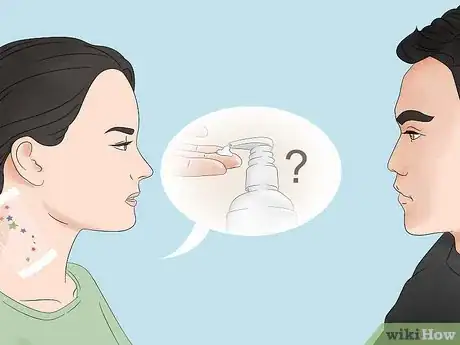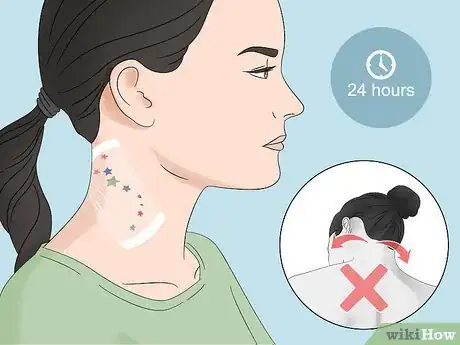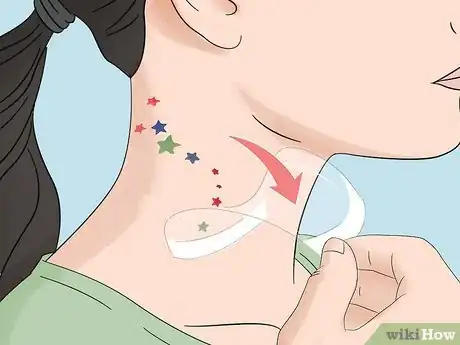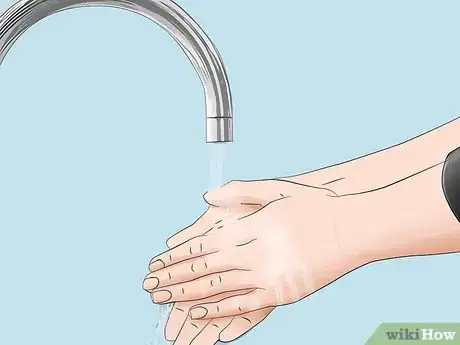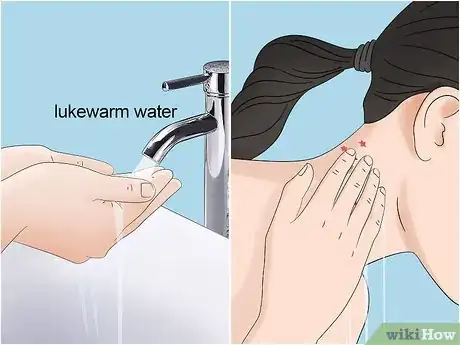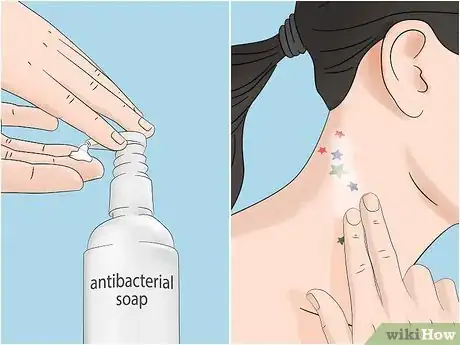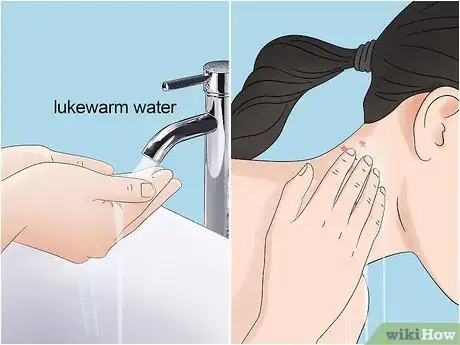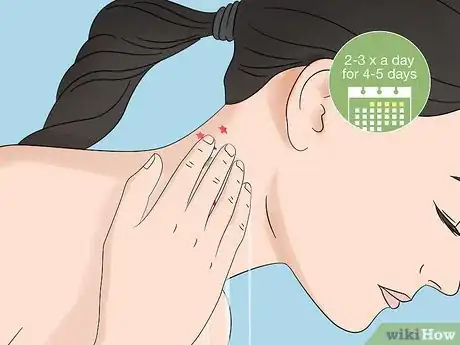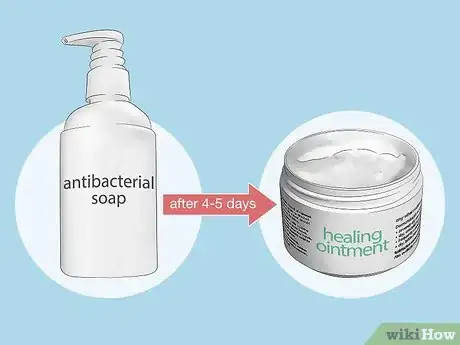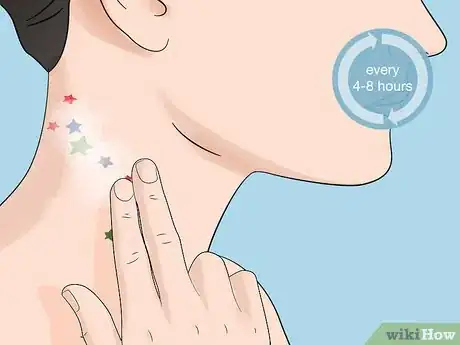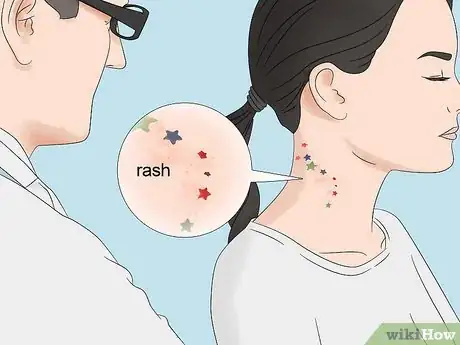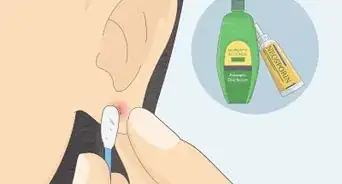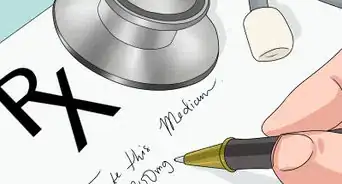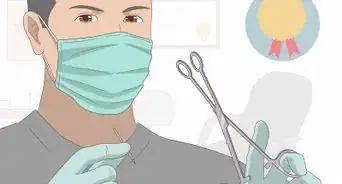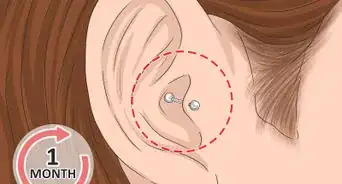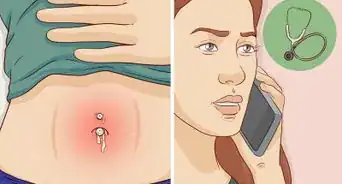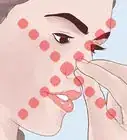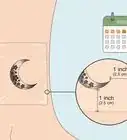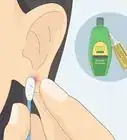This article was co-authored by Michelle Myles and by wikiHow staff writer, Eric McClure. Michelle Myles is the Co-owner of Daredevil Tattoo, a tattoo shop located based in New York City's Lower East Side. Michelle has more than 20 years of tattooing experience. She also operates the Daredevil Tattoo Museum, co-owner Brad Fink's personal collection of antique tattoo memorabilia that he has amassed over the last 27 years of tattooing.
This article has been viewed 27,722 times.
The neck is a striking place for a beautiful piece of body art, but caring for a neck tattoo can be kind of frustrating. You naturally move your neck a lot during the day and shirts often rub against the base of your neck, which makes it easy for this skin to get irritated while your fresh ink is healing. Washing a neck tattoo is easy enough since it’s cared for the same way you clean and wash a standard tattoo. Just skip out on the turtlenecks and keep your neck still for the first 24 hours after getting the tattoo and wash the tattoo regularly to help it heal.
Steps
Washing Your Tattoo for the First Time
-
1Ask the artist if there are any special instructions for your new tat. The tattoo artist is the expert in your new tattoo, so they’ll be the best source for aftercare instructions. If you got a lot of color or the tattoo was on a particularly thin part of your skin, there may be special requirements for your fresh ink. This may include letting it heal for an extra 24 hours or applying a special skin cream depending on the work you got done.[1]
- The tattoo artist should have covered the tattoo in a protective cream and put a bandage over it. If they didn’t do this, ask them why. This is a pretty standard practice.
- There’s nothing wrong with asking a bunch of questions! Most tattoo artists will be more than happy to help you out.
-
2Keep your neck as still as possible for the first 24 hours. Your neck is one of the few parts of your body that you constantly move without even thinking about it. For the first day after your tattoo, do your best to keep your head as still as you possibly can. This will keep your tattoo from bleeding or hurting too much while it begins healing.
- A little blood is pretty normal. Don’t be alarmed if you see some blood soaking through the bandage or wrap. See a doctor if the bleeding soaks through multiple bandages or it won’t stop after the first 24 hours.
- Don’t wear turtlenecks or other items of clothing that may brush against the tattoo.
Tip: If you normally sleep on your side, sleep on your back for the night after you get your tattoo. If the tat is on the back of your neck, prop your head up with an additional pillow or sleep on your stomach.
Advertisement -
3Remove the bandage 4-18 hours after getting the tattoo. Your tattoo artist applied an antibacterial cream to the tattoo after sealing it with the wrap or bandage. Leave this bandage on for at least 4 hours to give the cream time to kill any bacteria. There’s no harm in leaving the wrap or bandage on for a little longer, though. Take the bandage off carefully by peeling it from the corner without rubbing the tattoo itself.[2]
- Leave the bandage on overnight if you got the tattoo later in the day.
- You must wash the tattoo immediately after removing the bandage. Do not take the bandage off and then go to sleep or let it air out.
- If you don’t take the bandage off after 18 hours, the antibacterial cream will dry out and your tattoo could get infected.
-
4Scrub your hands with soap and water when you're ready to wash your tattoo. Before you wash your tattoo, wash your hands thoroughly to avoid introducing new bacteria. Squirt a liberal amount of antibacterial soap into your hands and rub them together for at least 2 minutes. Scrub your fingernails and in between the fingers to cover each surface with the soap while you’re washing.[3]
- Wash the tattoo as soon as you remove the bandage.
- When you take the bandage off, your hands will pick up any bacteria that was collecting on the exterior of the bandage. Do not skip this step, even if you recently cleaned your hands.
-
5Cup some lukewarm water in your hands and gently pour it over the tat. You can do this in the shower or at your sink. Turn the water on and wait for it to get comfortably warm. Hold your hands under the water and scoop it up. Pour the water over your neck 2-3 times to get the skin wet.[4]
- Do not hold the tattoo directly under the water. The goal is just to get the skin wet, not to soak it in a ton of water.
- If the tattoo is under your chin or on the back of your neck, this is pretty hard to do at the sink. You’re better off just doing it in the shower.
-
6Blot a dollop of antibacterial soap into the tattoo by hand. Any unscented antibacterial soap will work for this. Squirt a small bead of soap into your fingertips and gently blot it into your tattoo. Do not scrub or brush the tattoo with your fingers. Add enough soap to the skin to gently cover it with the antibacterial soap. Leave it on the skin for 30-45 seconds.[5]
- There are specialty tattoo soaps you can use if you prefer, but any unscented antibacterial soap will do the job just fine.
-
7Wash the excess soap off of your neck by pouring water over it. Wash the area you covered in soap the same way that you initially got your skin wet. Cup your hands under the water and pour it gently over the tattoo 4-5 times to wash the soap off.[6]
-
8Tap the area dry with a fresh cloth and wait 5-10 minutes. Grab a clean, dry cloth and ball it up in your hands. Gently tap the surface of the tattoo with the cloth to soak up the excess water. If the cloth gets damp after 4-5 taps, turn it over in your hand and repeat the process using a dry portion of the fabric. Let the skin air dry for 5-10 minutes.[7]
- You can use a paper towel instead of a fresh cloth if you prefer, but a cloth coming right out of the dryer is ideal since the dryer kills a lot of germs and bacteria. Just be sure to let it cool off a little before doing this.
-
9Apply a thin layer of unscented skin cream over the surface of the skin. Any fragrance-free lotion or skin cream will work so long as it’s water-based. Scoop up a thick bead of skin cream in your finger. Rub the cream over your tattoo until the ink is entirely covered in a layer of lotion. This will protect the skin and keep it from getting aggravated as you go about your day.[8]
- You can use a healing ointment if you prefer. Any unscented skin healing cream will work for this.
- If you have longer hair, tie it up to keep it from rubbing against your neck. Avoid wearing a hood, turtleneck, or shirts with high collars.
- Stay out of the sun as best as you can while your skin is healing.[9]
Warning: Do not use petroleum jelly or aloe vera. Petroleum jelly may cause the ink to fade while aloe vera will be painful and prevent healing.
Keeping Your Tattoo Clean while it Heals
-
1Wash your neck tattoo 2-3 times a day for 4-5 days.[10] Keep washing your tattoo every 6-8 hours to keep the tattoo clean and give your skin time to heal. This is a bit of a pain, but it’s extremely important that you keep the skin clean and protect it with an ointment or lotion. This will keep your skin safe and prevent the ink from being distorted.[11]
- You can still take regular showers while your skin is healing, but avoid leaving the tattoo directly under the water. Just keep your showers a little on the short side and use less shampoo than you normally do to keep the hair product off of your ink.
-
2Switch to a healing ointment after your skin starts flaking or shedding.[12] After 4-5 days of washing the tattoo, your skin will start peeling and flaking off. At this point, cut the washing routine out and switch to a healing ointment. You can still shower and everything, but do not use any soap on your neck. Instead, you will use the healing cream to replenish your skin and keep it moist. Any unscented healing cream with plenty of fatty acids will work quite well.[13]
- Apply this healing cream at the end of every shower. You’ll use it more often than this, but it’s especially important to do it after you get out of the shower.
- Choose a healing ointment with tea tree oil or vitamin A, D, or E. Pure cocoa or shea butter can work as well. Just stay away from aloe vera, which will actually make the healing process take longer.[14]
- You can still use soap on the rest of your body. Just keep it off of your neck tattoo.
-
3Rub a thin layer of your healing ointment into the skin. Using the healing cream is pretty straightforward. Scoop up a small dollop of healing cream with your index and middle fingers. Blot the tattoo with the healing cream and scoop up more moisturizer as needed until you completely cover the tattoo in a thin layer of healing cream.[15]
- You can run your hand over the skin to spread the ointment out if it doesn’t hurt, but don’t use too much force.
Warning: Do not pick at, scratch, or rub the tattoo while it’s healing. It can be pretty tempting to mess with the tattoo while it’s peeling and flaking, but you may damage the ink if you do this.
-
4Repeat this process whenever you feel your skin drying out. How often you need to reapply the healing ointment depends on the temperature, how quickly your skin dries out, and how much time you’re spending outside. Continue reapplying the healing cream whenever the skin gets dry. You may need to reapply the healing cream every 4-8 hours depending on how you’re spending your time.[16]
- Apply the healing cream as soon as you get out of the shower and right before you go to bed.
- You may need to do this for 2-3 weeks. A tattoo is done healing when the tattooed skin is identical to the texture and look of your normal skin. At that point, you can wash your neck the same way you wash the rest of your body!
-
5Contact a doctor if your skin swells or you see a rash developing. If some bacteria gets into the tattoo as it heals or your skin isn’t handling the ink well, you may have a reaction. Don’t worry if this happens—it’s an extremely common issue—but you do need to see a dermatologist or doctor. In most cases, this can be cleared up with a simple antibiotic.[17]
Expert Q&A
Did you know you can get expert answers for this article?
Unlock expert answers by supporting wikiHow
-
QuestionWhat should I do if my neck tattoo is infected?
 Michelle MylesMichelle Myles is the Co-owner of Daredevil Tattoo, a tattoo shop located based in New York City's Lower East Side. Michelle has more than 20 years of tattooing experience. She also operates the Daredevil Tattoo Museum, co-owner Brad Fink's personal collection of antique tattoo memorabilia that he has amassed over the last 27 years of tattooing.
Michelle MylesMichelle Myles is the Co-owner of Daredevil Tattoo, a tattoo shop located based in New York City's Lower East Side. Michelle has more than 20 years of tattooing experience. She also operates the Daredevil Tattoo Museum, co-owner Brad Fink's personal collection of antique tattoo memorabilia that he has amassed over the last 27 years of tattooing.
Tattoo Artist & Co-owner, Daredevil Tattoo
-
QuestionWhat's the best way to prevent an infection?
 Michelle MylesMichelle Myles is the Co-owner of Daredevil Tattoo, a tattoo shop located based in New York City's Lower East Side. Michelle has more than 20 years of tattooing experience. She also operates the Daredevil Tattoo Museum, co-owner Brad Fink's personal collection of antique tattoo memorabilia that he has amassed over the last 27 years of tattooing.
Michelle MylesMichelle Myles is the Co-owner of Daredevil Tattoo, a tattoo shop located based in New York City's Lower East Side. Michelle has more than 20 years of tattooing experience. She also operates the Daredevil Tattoo Museum, co-owner Brad Fink's personal collection of antique tattoo memorabilia that he has amassed over the last 27 years of tattooing.
Tattoo Artist & Co-owner, Daredevil Tattoo The most important thing is to wash your tattoo a couple of times a day for the first few days. Use your hands and a very mild soap. Don't use a washcloth since washcloths tend to hold bacteria. Keep washing it a couple of times a day until it starts to peel. That's when you want to leave it alone and just moisturize it if it's itchy.
The most important thing is to wash your tattoo a couple of times a day for the first few days. Use your hands and a very mild soap. Don't use a washcloth since washcloths tend to hold bacteria. Keep washing it a couple of times a day until it starts to peel. That's when you want to leave it alone and just moisturize it if it's itchy. -
QuestionWhat do you do if your tattoo is flaking?
 Michelle MylesMichelle Myles is the Co-owner of Daredevil Tattoo, a tattoo shop located based in New York City's Lower East Side. Michelle has more than 20 years of tattooing experience. She also operates the Daredevil Tattoo Museum, co-owner Brad Fink's personal collection of antique tattoo memorabilia that he has amassed over the last 27 years of tattooing.
Michelle MylesMichelle Myles is the Co-owner of Daredevil Tattoo, a tattoo shop located based in New York City's Lower East Side. Michelle has more than 20 years of tattooing experience. She also operates the Daredevil Tattoo Museum, co-owner Brad Fink's personal collection of antique tattoo memorabilia that he has amassed over the last 27 years of tattooing.
Tattoo Artist & Co-owner, Daredevil Tattoo
Warnings
- Keep the tattoo out of the sun while it’s healing. The more time you spend in the sun, the more likely the tattoo will be to fade or become distorted. You can put a gauze pad over the tattoo while it heals if you work outside or can’t stay indoors.[18]⧼thumbs_response⧽
- Do not use petroleum jelly or aloe vera to protect your tattoo. These products are not great for ink and will actively harm your skin if you use them on fresh ink.[19]⧼thumbs_response⧽
- Stay away from tanning beds while your tattoo is healing. The UV light may react with the ink and distort the tattoo.[20]⧼thumbs_response⧽
References
- ↑ https://uhs.umich.edu/bodyart
- ↑ https://uhs.umich.edu/bodyart
- ↑ https://www.health.harvard.edu/blog/tattoos-and-infection-think-before-you-ink-201210125405
- ↑ https://youtu.be/xvVROM3-Af4?t=102
- ↑ https://uhs.umich.edu/bodyart
- ↑ https://u.osu.edu/buckmdblog/2011/08/07/how-safe-is-that-tattoo/
- ↑ https://uhs.umich.edu/bodyart
- ↑ https://www.aad.org/public/everyday-care/skin-care-basics/tattoos/caring-for-tattooed-skin
- ↑ Michelle Myles. Tattoo Artist. Expert Interview. 4 November 2019.
- ↑ Michelle Myles. Tattoo Artist. Expert Interview. 4 November 2019.
- ↑ https://www.health.harvard.edu/blog/tattoos-and-infection-think-before-you-ink-201210125405
- ↑ Michelle Myles. Tattoo Artist. Expert Interview. 4 November 2019.
- ↑ https://uhs.umich.edu/bodyart
- ↑ https://uhs.umich.edu/bodyart
- ↑ https://www.health.harvard.edu/blog/tattoos-and-infection-think-before-you-ink-201210125405
- ↑ https://www.health.harvard.edu/blog/tattoos-and-infection-think-before-you-ink-201210125405
- ↑ https://www.health.harvard.edu/blog/tattoos-and-infection-think-before-you-ink-201210125405
- ↑ https://uhs.umich.edu/bodyart
- ↑ https://www.aad.org/public/everyday-care/skin-care-basics/tattoos/caring-for-tattooed-skin
- ↑ https://www.aad.org/public/everyday-care/skin-care-basics/tattoos/caring-for-tattooed-skin
